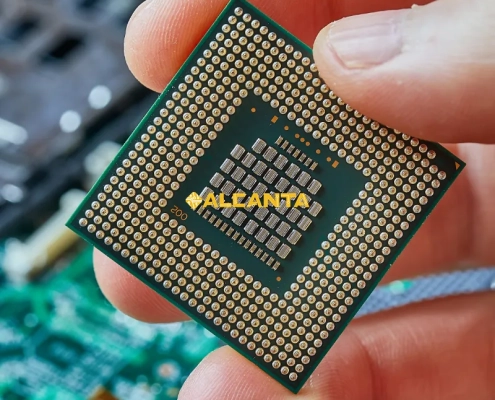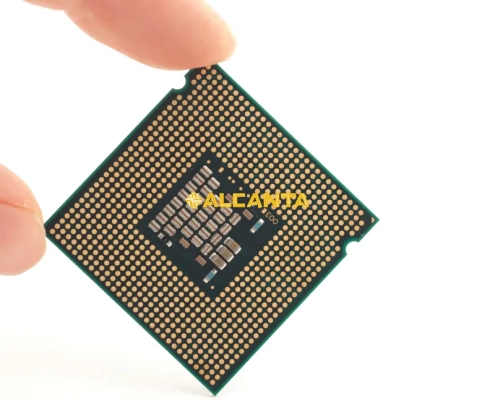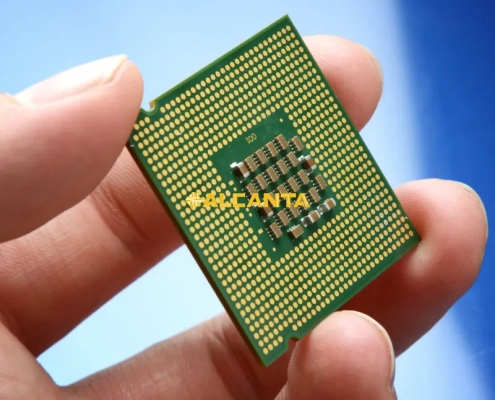SiP vs. SoC: Decoding Integration Strategies
In the ever-evolving landscape of electronics packaging, SiP (System-in-Package) emerges as a pivotal solution, integrating diverse components within a single enclosure. SiP packages have become indispensable in meeting the escalating consumer demand for compact, multifunctional electronic devices. This demand stems from the relentless pursuit of portability, performance, and versatility in gadgets such as smartphones, wearables, and IoT devices. As technology advances, the complexity of functionalities packed into these devices surges, necessitating a more efficient packaging solution. SiP packages offer a comprehensive approach, accommodating diverse components like microprocessors, memory modules, and sensors within a confined space. Consequently, they pave the way for streamlined manufacturing processes, reduced form factors, and enhanced system performance, addressing the challenges posed by modern electronics design.
What is SiP in Packaging?
Exploring SiP Package Components
SiP packages offer a remarkable level of versatility by accommodating an extensive array of components, thereby enabling the creation of highly integrated electronic systems. Let’s delve into the diverse components that can be seamlessly integrated within a SiP package:
Microprocessors: SiP packages can incorporate powerful microprocessors, serving as the brain of the electronic system. These microprocessors handle computation, control, and communication tasks, facilitating seamless operation.
Memory Modules: Various types of memory modules, including RAM (Random Access Memory) and ROM (Read-Only Memory), can be integrated into SiP packages. This ensures efficient data storage and retrieval, enhancing overall system performance.
Sensors: SiP packages can integrate a wide range of sensors such as accelerometers, gyroscopes, temperature sensors, and proximity sensors. These sensors enable the detection and measurement of physical parameters, enabling diverse functionalities in electronic devices.
RF Components: SiP packages can incorporate RF (Radio Frequency) components like antennas, transceivers, and amplifiers. These components enable wireless communication capabilities, essential for devices such as smartphones, IoT devices, and wireless sensors.
Flexibility and Customization: One of the key advantages of SiP packaging is its inherent flexibility and customization options. Designers can tailor SiP packages to meet specific application requirements by selecting and integrating the most suitable components. Additionally, SiP packages allow for the integration of components with different form factors, technologies, and functionalities onto a single substrate, enhancing design flexibility and optimization.
SiP Package Substrate: The substrate material used in SiP packaging plays a crucial role in providing structural integrity, electrical connectivity, and thermal management. Common substrates include organic materials like FR-4 (Flame Retardant-4) and high-performance materials like silicon and glass. The choice of substrate influences the overall performance, reliability, and cost-effectiveness of SiP packages.
In essence, SiP packages offer unparalleled flexibility and customization capabilities, empowering designers to create innovative electronic systems tailored to specific application requirements.
SiP Package Architecture
Benefits of SiP Packaging
SiP technology brings forth a plethora of advantages, revolutionizing the landscape of electronic packaging. Let’s delve into the various benefits offered by SiP packaging and explore real-world applications where its advantages are evident:
Reduced Footprint: SiP packages enable the integration of multiple components within a single enclosure, significantly reducing the overall footprint of electronic devices. This compact form factor is particularly advantageous in applications where space constraints are critical, such as mobile devices, wearables, and IoT sensors.
Improved Performance: By consolidating multiple components into a cohesive package, SiP technology minimizes signal propagation delays and improves interconnectivity between components. This results in enhanced system performance, reduced latency, and improved overall efficiency, making SiP packages ideal for high-performance computing, telecommunications, and networking applications.
Enhanced Reliability: SiP packaging offers superior reliability compared to traditional assembly methods, thanks to optimized interconnectivity and reduced parasitic effects. Additionally, the use of advanced substrate materials, such as the SIP Package Substrate, ensures structural integrity, electrical connectivity, and robust thermal management, enhancing the overall reliability and longevity of electronic devices.
Real-World Applications
Smartphones: SiP packages play a pivotal role in the design of modern smartphones, where space optimization is crucial. By integrating components like processors, memory modules, and RF components into a single package, SiP technology enables manufacturers to create sleek, feature-rich smartphones with advanced functionality and superior performance.
Wearable Devices: Wearable devices, such as smartwatches and fitness trackers, rely on SiP packaging to achieve compact form factors and long battery life. By integrating sensors, microcontrollers, and wireless communication modules within a SiP package, wearable devices can deliver real-time data monitoring and seamless connectivity in a small, lightweight package.
IoT Sensors: In the realm of IoT (Internet of Things), SiP packages are instrumental in the development of sensor nodes and edge devices. By integrating sensors, microcontrollers, and communication modules into a single package, SiP technology enables the deployment of cost-effective, energy-efficient IoT solutions for various applications, including smart home automation, industrial monitoring, and environmental sensing.
SiP packaging offers a myriad of benefits, including reduced footprint, improved performance, and enhanced reliability, making it a preferred choice for a wide range of applications spanning consumer electronics, telecommunications, automotive, healthcare, and industrial sectors. Through real-world examples and case studies, the advantages of SiP technology become evident, showcasing its transformative impact on the electronics industry.
Challenges and Considerations
Challenges Associated with SiP Packaging
SiP packages offer remarkable advantages, but they also come with their set of challenges that need to be addressed for successful implementation:
Thermal Management: Integrating multiple components within a confined space can lead to increased heat generation, posing challenges in thermal management. Efficient heat dissipation is crucial to prevent overheating and ensure the reliability and longevity of SiP packages. The selection of appropriate substrate materials, such as the SIP Package Substrate, with high thermal conductivity, and the incorporation of thermal management solutions like heat sinks, thermal vias, and thermal interface materials, are essential strategies for addressing thermal challenges in SiP packaging.
Signal Integrity: The close proximity of components within SiP packages can result in signal interference and degradation, affecting signal integrity and overall system performance. Proper signal routing, impedance matching, and electromagnetic interference (EMI) shielding techniques are essential to maintain signal integrity and minimize electromagnetic interference. Advanced simulation and modeling tools can help identify potential signal integrity issues early in the design phase, allowing for timely adjustments and optimizations.
Cost: SiP packaging typically involves higher manufacturing costs compared to traditional packaging techniques due to the complexity of integration and the use of advanced materials and processes. Cost considerations are particularly significant for high-volume consumer electronics applications, where cost-effectiveness is paramount. Strategies for cost optimization include design simplification, component integration, substrate material selection, and leveraging economies of scale through strategic partnerships and supply chain optimizations.
Mitigating Challenges and Optimizing SiP Designs
To address the challenges associated with SiP packaging and optimize SiP designs for specific applications, several strategies can be employed:
- Collaborative Design Approach: Adopting a collaborative design approach involving multidisciplinary teams comprising engineers, designers, and manufacturing experts can facilitate holistic problem-solving and optimization of SiP designs. Cross-functional collaboration enables the identification of potential challenges early in the design phase and allows for the implementation of innovative solutions.
- Simulation and Modeling: Utilizing advanced simulation and modeling tools enables designers to predict and analyze the behavior of SiP packages under various operating conditions. Virtual prototyping allows for the exploration of different design configurations, materials, and manufacturing processes, enabling informed decision-making and optimization of SiP designs.
- Material Selection: Careful selection of substrate materials, such as the SIP Package Substrate, is crucial for optimizing SiP designs for thermal management, electrical performance, and reliability. High-performance substrate materials with excellent thermal conductivity, electrical properties, and mechanical stability can enhance the overall performance and reliability of SiP packages.
- Design for Manufacturability: Designing SiP packages with manufacturability in mind is essential for ensuring cost-effective and efficient production. Design optimizations aimed at simplifying assembly processes, reducing component count, and minimizing material waste can streamline manufacturing workflows and lower production costs.
By addressing common challenges and implementing optimization strategies, SiP designers can overcome technical hurdles and unlock the full potential of SiP technology for a wide range of applications, from consumer electronics to automotive, aerospace, and beyond.
SiP vs. SoC: Understanding the Differences
When it comes to integrating components into electronic systems, System-in-Package (SiP) and System-on-Chip (SoC) represent two distinct approaches with unique advantages and considerations. Let’s compare these technologies in detail, focusing on their architectures, integration levels, and design considerations:
Architectures
- SiP: SiP packages involve integrating multiple components or subsystems within a single package. These components may include microprocessors, memory modules, sensors, and RF components. SiP packages utilize advanced interconnection methods to establish electrical connections between components and the substrate, such as wire bonding, flip-chip bonding, and through-silicon vias (TSVs).
- SoC: SoC, on the other hand, integrates all essential system components onto a single semiconductor chip. This includes microprocessors, memory, input/output interfaces, and other functional blocks. SoC architectures typically involve complex system-on-chip designs, where all components are fabricated onto a single silicon die using advanced semiconductor manufacturing processes.
Integration Levels
- SiP: SiP packages offer a high degree of integration by consolidating multiple components within a single package. This allows for the integration of diverse functionalities and enables the creation of compact, multifunctional electronic systems.
- SoC: SoC technologies achieve the highest level of integration by incorporating all system components onto a single semiconductor chip. This results in a highly integrated solution with reduced footprint, power consumption, and manufacturing complexity.
Design Considerations
- SiP: Designing SiP packages requires careful consideration of factors such as thermal management, signal integrity, and cost. Selection of appropriate substrate materials, such as the SIP Package Substrate, is crucial for ensuring structural integrity, electrical connectivity, and thermal dissipation. SiP designs also offer greater flexibility and customization options, allowing for tailored solutions to meet specific application requirements.
- SoC: SoC designs involve complex system-on-chip architectures and require expertise in semiconductor design, fabrication, and testing. Design considerations include optimizing chip layout, minimizing power consumption, and ensuring compatibility with external interfaces and peripherals. SoC designs typically involve higher upfront development costs but may offer economies of scale in high-volume production.
Scenarios for Preference
- SiP Preferred: SiP packages are preferred in scenarios where diverse functionalities need to be integrated within a compact form factor. They are well-suited for applications with space constraints, such as mobile devices, wearables, and IoT sensors. SiP packages also offer greater flexibility for system customization and scalability.
- SoC Preferred: SoC technologies are preferred for applications where the highest level of integration, performance, and power efficiency is required. They are commonly used in applications such as smartphones, tablets, and embedded systems, where compactness, power efficiency, and performance are critical.
SiP and SoC technologies offer distinct advantages and considerations, making them suitable for different application scenarios. While SiP packages provide flexibility, customization, and integration advantages, SoC solutions offer the highest level of integration and performance. The choice between SiP and SoC depends on specific application requirements, trade-offs between integration levels, performance, power consumption, and cost considerations.
FAQs About SIP Package
What is SiP in packaging?
SiP in packaging stands for System-in-Package. It’s a technology that integrates multiple components or subsystems into a single package, offering compactness and enhanced performance.
What is a SiP package?
A SiP package refers to a packaging technology where multiple components or subsystems are integrated into a single enclosure. These components can include microprocessors, memory modules, sensors, and RF components, among others.
What is a SiP module?
A SiP module is a compact assembly that incorporates various components or subsystems within a SiP package. It typically includes a combination of microprocessors, memory modules, sensors, and other functional elements tailored to specific applications.
What is the difference between SiP and SoC?
The main difference between SiP (System-in-Package) and SoC (System-on-Chip) lies in their integration approach. SiP integrates multiple components or subsystems within a single package, offering flexibility and customization options. In contrast, SoC integrates all essential system components onto a single semiconductor chip, achieving the highest level of integration but with less flexibility in customization.



